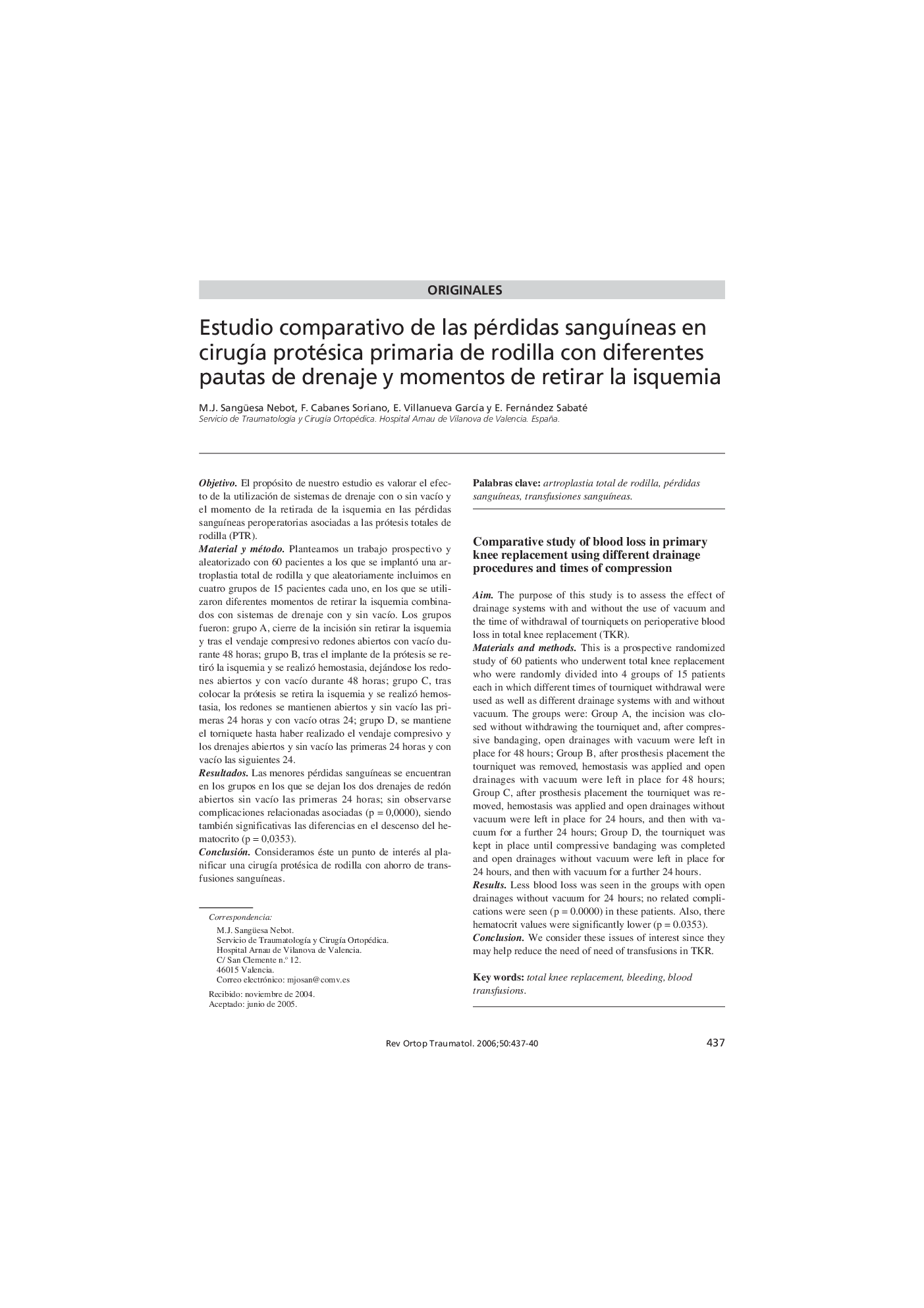| Article ID | Journal | Published Year | Pages | File Type |
|---|---|---|---|---|
| 4086980 | Revista Española de Cirugía Ortopédica y Traumatología | 2006 | 4 Pages |
ObjetivoEl propósito de nuestro estudio es valorar el efecto de la utilización de sistemas de drenaje con o sin vacío y el momento de la retirada de la isquemia en las pérdidas sanguíneas peroperatorias asociadas a las prótesis totales de rodilla (PTR).Material y métodoPlanteamos un trabajo prospectivo y aleatorizado con 60 pacientes a los que se implantó una artroplastia total de rodilla y que aleatoriamente incluimos en cuatro grupos de 15 pacientes cada uno, en los que se utilizaron diferentes momentos de retirar la isquemia combinados con sistemas de drenaje con y sin vacío. Los grupos fueron: grupo A, cierre de la incisión sin retirar la isquemia y tras el vendaje compresivo redones abiertos con vacío durante 48 horas; grupo B, tras el implante de la prótesis se retiró la isquemia y se realizó hemostasia, dejándose los redones abiertos y con vacío durante 48 horas; grupo C, tras colocar la prótesis se retira la isquemia y se realizó hemostasia, los redones se mantienen abiertos y sin vacío las primeras 24 horas y con vacío otras 24; grupo D, se mantiene el torniquete hasta haber realizado el vendaje compresivo y los drenajes abiertos y sin vacío las primeras 24 horas y con vacío las siguientes 24.ResultadosLas menores pérdidas sanguíneas se encuentran en los grupos en los que se dejan los dos drenajes de redón abiertos sin vacío las primeras 24 horas; sin observarse complicaciones relacionadas asociadas (p = 0,0000), siendo también significativas las diferencias en el descenso del hematocrito (p = 0,0353).ConclusiónConsideramos éste un punto de interés al planificar una cirugía protésica de rodilla con ahorro de transfusiones sanguíneas.
AimThe purpose of this study is to assess the effect of drainage systems with and without the use of vacuum and the time of withdrawal of tourniquets on perioperative blood loss in total knee replacement (TKR).Materials and methodsThis is a prospective randomized study of 60 patients who underwent total knee replacement who were randomly divided into 4 groups of 15 patients each in which different times of tourniquet withdrawal were used as well as different drainage systems with and without vacuum. The groups were: Group A, the incision was closed without withdrawing the tourniquet and, after compressive bandaging, open drainages with vacuum were left in place for 48 hours; Group B, after prosthesis placement the tourniquet was removed, hemostasis was applied and open drainages with vacuum were left in place for 48 hours; Group C, after prosthesis placement the tourniquet was removed, hemostasis was applied and open drainages without vacuum were left in place for 24 hours, and then with vacuum for a further 24 hours; Group D, the tourniquet was kept in place until compressive bandaging was completed and open drainages without vacuum were left in place for 24 hours, and then with vacuum for a further 24 hours.ResultsLess blood loss was seen in the groups with open drainages without vacuum for 24 hours; no related complications were seen (p = 0.0000) in these patients. Also, there hematocrit values were significantly lower (p = 0.0353).ConclusionWe consider these issues of interest since they may help reduce the need of need of transfusions in TKR.
